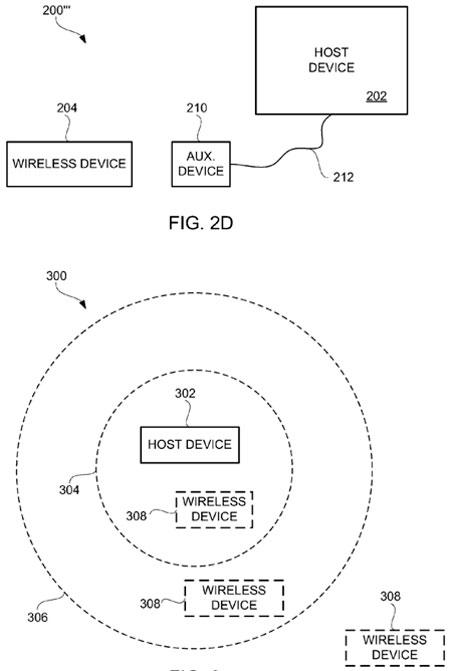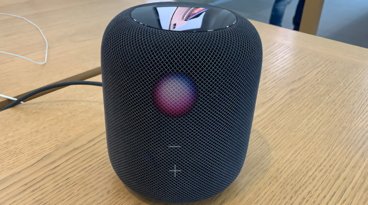Apple seeks distance-based pairing, auto contact data patents
A pair of filings for US patents made by Apple would make users' lives easier by letting them pair wireless devices just by bringing them together as well as filling out missing address book data simply by making a request through e-mail.
The first of the patents tackles the problem of simplifying the link-up between a short-range wireless device and its host.
With Bluetooth and other standards, pairing often requires a PIN number to prevent accidental pairings or rogue devices from hopping on to the peripheral network. However, entering a PIN is often entirely impractical: many Bluetooth headsets, input devices, and even whole handheld devices are often too small or otherwise too unwieldy to enter one of these codes, Apple says.
The proposed solution would solve this problem by determining the range of the wireless link between the new device and its host. If both near within a foot of each other and are receptive to a new link, the two will automatically pair and potentially exchange extra data as long as neither hardware item wanders out of range. This would create a secure connection without accepting the wrong device.
Apple's submission ultimately bears a strong resemblance to a subset of the Bluetooth 2.1 spec known as Near Field Communications, or NFC, which is meant to perform the same role: by bringing a phone near a headset or a terminal, the standard can simplify the pairing process or allow automatic payment at a store.
However, the patent expands this to include any standard technically capable of the feat and also comes with more specific examples, such as a wireless-capable dock or an in-car adapter connecting to a cellphone or portable media player.
The Cupertino, Calif.-based firm is already using one aspect of the tentative patent. The patent raises the possibility of making the wireless pairing through a temporary physical connection, which was already implemented in the company's iPhone Dual Dock for its original cellphone. At present, though, both the original iPhone and iPhone 3G use Bluetooth 2.0 and don't support NFC.
A representational model of Apple's proximity-based wireless pairing patent.
System and method for opportunistic image sharing
A second patent filing would solve the common problem of having to fill out contact information without necessarily having all the data already in place.
Mail in Mac OS X Leopard already implements triggers known as data receptors, which automatically recognize certain information and can populate a new address book listing with phone numbers and similar data embedded in the message. When that information isn't already built in, however, the Apple software currently doesn't have a solution of its own.
The suggested technique in the patent would let users fill in these details over email. A new message to one of the user's contacts could include a specially-coded request for one or more pieces of information; recipients would only need to accept the request and would then automatically send photos, text, or other data without having to search the computer by hand.
Such a method could also make the requests themselves automatically and so could keep an entire group of users updated just through day-to-day email correspondence.
Apple hasn't revealed any immediate signs that it plans to implement the technology in a future Mac OS X update, though the filing credits the company's Senior VP of Software Engineering, Bertrand Serlet, as the sole inventor.
 Aidan Malley
Aidan Malley














 Amber Neely
Amber Neely
 Thomas Sibilly
Thomas Sibilly
 AppleInsider Staff
AppleInsider Staff
 William Gallagher
William Gallagher
 Malcolm Owen
Malcolm Owen
 Christine McKee
Christine McKee









13 Comments
Very useful for Bluetooth mice as they use empty key passes. For keyboards, it might require support on the keyboard. Mice don't move far so there shouldn't be a pairing issue in an office. I could see a problem if you have a laptop on a desk beside your desktop though. It can't automatically know you'd want to pair with the desktop. Some bluetooth devices only allow pairing one device at a time so it would always want to switch to the laptop. I guess they'd have to have a block pairing option to prevent auto-pairing in the OS too.
I've always found it unnecessarily complicated to share files between two macbooks or a macbook and windows PC sitting right next to each other.
Hopefully this might help.
I see a whole host of problems. Say you are in a meeting with your laptop and cellphone. Everyone else in the meeting has a laptop and cellphone. And they all have this new distance-based autoconnect feature. All hell breaks loose when they all try to autoconnect to each other, and the security implications are too dreadful to think about!
Now what about making a real mouse Apple?
I could see a problem if you have a laptop on a desk beside your desktop though. It can't automatically know you'd want to pair with the desktop. Some bluetooth devices only allow pairing one device at a time so it would always want to switch to the laptop. I guess they'd have to have a block pairing option to prevent auto-pairing in the OS too.
You only need to pair once ever. The two devices remember the pairing.
You do this by bringing the devices together. Once.
NFC only has a 10cm range, so you need to have physical access to the machine to use it anyway.